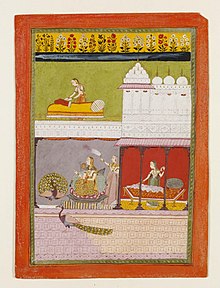
Ravi Shankar was an Indian sitarist and composer. A sitar virtuoso, he became the world's best-known expert of North Indian classical music in the second half of the 20th century, and influenced many musicians in India and throughout the world. Shankar was awarded India's highest civilian honour, the Bharat Ratna, in 1999.

Carnatic music, known as Karnāṭaka saṃgīta or Karnāṭaka saṅgītam in the South Indian languages, is a system of music commonly associated with South India, including the modern Indian states of Andhra Pradesh, Karnataka, Kerala, Tamil Nadu and Telangana. It is one of two main subgenres of Indian classical music that evolved from ancient Hindu texts and traditions, particularly the Samaveda. The other subgenre is Hindustani music, which emerged as a distinct form because of Persian or Islamic influences from Northern India. The main emphasis in Carnatic music is on vocal music; most compositions are written to be sung, and even when played on instruments, they are meant to be performed in gāyaki (singing) style.
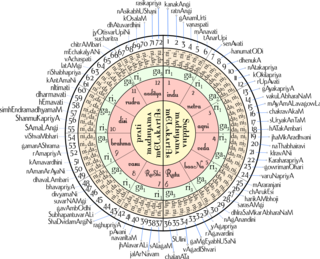
A raga is a melodic framework for improvisation in Indian classical music akin to a melodic mode. Rāga is central to classical Indian music and a unique feature of the tradition: no equivalent concept exists in Western classical music. Each rāga consists of an array of melodic structures with musical motifs; and, from the perspective of the Indian tradition, the resulting music has the ability to "colour the mind" as it engages the emotions of the audience.
Khyal or Khayal is a major form of Hindustani classical music in the Indian subcontinent. Its name comes from a Persian/Arabic word meaning "imagination". Khyal is associated with romantic poetry, and allows the performer greater freedom of expression than dhrupad. In khyal, ragas are extensively ornamented, and the style calls for more technical virtuosity.

Indian Classical Music is the classical music of the Indian Subcontinent. It is generally described using terms like Marg Sangeet and Shastriya Sangeet. It has two major traditions: the North Indian classical music known as Hindustani and the South Indian expression known as Carnatic. These traditions were not distinct until about the 15th century. During the period of Mughal rule of the Indian subcontinent, the traditions separated and evolved into distinct forms. Hindustani music emphasizes improvisation and exploration of all aspects of a raga, while Carnatic performances tend to be short composition-based. However, the two systems continue to have more common features than differences. Another unique classical music tradition from the eastern part of India is Odissi music, which has evolved over the last two thousand years.

Hariprasad Chaurasia is an Indian music director and classical flautist, who plays the bansuri, in the Hindustani classical tradition.

Ramtanu Pandey, popularly referred to as Mian Tansen, or Sangeet Samrat, was a Hindustani classical musician. Born into a Hindu Gaur Brahmin family, he learnt and perfected his art in the northwest region of modern Madhya Pradesh. He began his career and spent most of his adult life in the court and patronage of the Hindu king of Rewa, Raja Ramchandra Singh, where Tansen's musical abilities and studies gained widespread fame. This reputation brought him to the attention of the Mughal Emperor Akbar, who sent messengers to Raja Ramchandra Singh, requesting Tansen to join the musicians at the Mughal court. Tansen did not want to go, but Raja Ramchandra Singh encouraged him to gain a wider audience and sent him along with gifts for Akbar. In 1562, at about the age of 60, the Vaishnava musician Tansen joined Akbar's court, and his performances became the subject of many court historians.
Hindustani classical music is the classical music of the Indian subcontinent's northern regions. It may also be called North Indian classical music or, in Hindustani, shastriya sangeet. The term shastriya sangeet literally means classical music, and is also used to refer to Indian classical music in general. It is played on instruments like the veena, sitar and sarod. It originated in the 12th century CE, when it diverged from Carnatic music, the classical tradition of South India. While Carnatic music largely uses compositions written in Sanskrit, Kannada, Telugu, Tamil, Malayalam, Hindustani music largely uses compositions written in Hindi-Urdu, Braj, Avadhi, Rajasthani, and Punjabi.
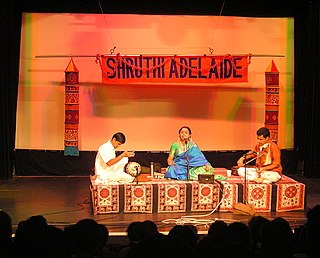
The shruti or śruti is the smallest interval of pitch that the human ear can detect and a singer or musical instrument can produce. The concept is found in ancient and medieval Sanskrit texts such as the Natya Shastra, the Dattilam, the Brihaddeshi, and the Sangita Ratnakara. Chandogya Upanishad speaks of the division of the octave in 22 parts.
A thaat is a "parent scale" in North Indian or Hindustani music. It is the Hindustani equivalent of the term Melakartha raga of Carnatic music. The concept of the thaat is not exactly equivalent to the western musical scale because the primary function of a thaat is not as a tool for music composition, but rather as a basis for classification of ragas. There is not necessarily strict compliance between a raga and its parent thaat; a raga said to 'belong' to a certain thaat need not allow all the notes of the thaat, and might allow other notes. Thaats are generally accepted to be heptatonic by definition.

Raga rock is rock or pop music with a pronounced Indian influence, either in its construction, its timbre, or its use of Indian musical instruments, such as the sitar, tambura, and tabla. The term "raga" refers to the specific melodic modes used in Indian classical music.

Ustad Allauddin Khan, also known as was an Indian sarod player and multi-instrumentalist, composer and one of the most notable music teachers of the 20th century in Indian classical music. For a generation many of his students, across different instruments like sitar and violin, dominated Hindustani classical and became one of the most famous exponents of the form ever, includingKhan.

Kambhoji or Kambodhi is a popular Raga in Carnatic Music. It is classified as a derived raga from 28th Melakartha, Harikambhoji, and has existed since the 7th century.
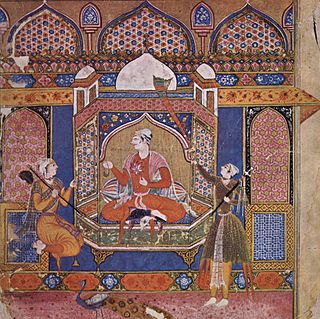
Shree is a very old North Indian raga of the Purvi thaat, and has traditionally been associated with Laxmi. It also appears in the Sikh tradition from northern India, and is a part of the Guru Granth Sahib, the holy text of the Sikhs. The Guru Granth Sahib composition comprises 31 ragas where Shree is the first raga to appear. The raga appears first on 14th page of the composition.
Gamaka refer to ornamentation that is used in the performance of North and South Indian classical music. Gamaka can be understood as embellishment done on a note or between two notes. Present-day Carnatic music uses at least fifteen different kinds of ornamentation. Gamaka is any graceful turn, curve or cornering touch given to a single note or a group of notes, which adds emphasis to each raga's individuality. Gamaka can be understood as any movement done on a note or in between two notes. The unique character of each raga is given by its gamakas, making their role essential rather than decorative in Indian music. Nearly all Indian musical treatises have a section dedicated to describing, listing and characterising gamakas.
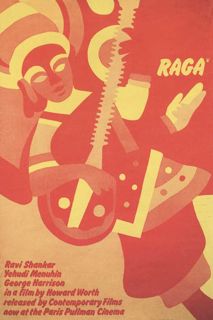
Raga is a 1971 documentary film about the life and music of Indian sitarist Ravi Shankar, produced and directed by Howard Worth. It includes scenes featuring Western musicians Yehudi Menuhin and George Harrison, as well as footage of Shankar returning to Maihar in central India, where as a young man he trained under the mentorship of Allauddin Khan. The film also features a portion of Shankar and tabla player Alla Rakha's acclaimed performance at the 1967 Monterey Pop Festival.

Malkauns, known also as rag Malkosh, is a raga in Indian classical music. It is one of the oldest ragas of Indian classical music. The equivalent raga in Carnatic music is called Hindolam, not to be confused with the Hindustani Hindol.

Ravi Shankar's Music Festival from India was an Indian classical music revue led by sitarist and composer Ravi Shankar intended for Western concert audiences and performed in 1974. Its presentation was the first project undertaken by the Material World Charitable Foundation, set up the previous year by ex-Beatle George Harrison. Long a champion of Indian music, Harrison also produced an eponymous studio album by the Music Festival orchestra, which was released in 1976 on his Dark Horse record label. Both the CD format of the Ravi Shankar's Music Festival from India album and a DVD of their performance at the Royal Albert Hall in London were issued for the first time on the 2010 Shankar–Harrison box set Collaborations.

In Concert 1972 is a double live album by sitar virtuoso Ravi Shankar and sarodiya Ali Akbar Khan, released in 1973 on Apple Records. It was recorded at the Philharmonic Hall, New York City, in October 1972, and is a noted example of the two Hindustani classical musicians' celebrated jugalbandi (duet) style of playing. With accompaniment from tabla player Alla Rakha, the performance reflects the two artists' sorrow at the recent death of their revered guru, and Khan's father, Allauddin Khan. The latter was responsible for many innovations in Indian music during the twentieth century, including the call-and-response dialogue that musicians such as Shankar, Khan and Rakha popularised among Western audiences in the 1960s.
Kamala Chakravarty is an Indian classical musician and former dancer, known for her association with sitar maestro Ravi Shankar. From 1967 until the late 1970s, she accompanied Shankar, in the role of tambura player and singer, in a number of acclaimed performances, including the Monterey International Pop Festival (1967), his Human Rights Day duet with violinist Yehudi Menuhin (1967), the Concert for Bangladesh (1971) and the Music Festival from India (1974). She lived with Shankar as his "wife" from 1967 to 1981, while he was still married to musician and teacher Annapurna Devi.
